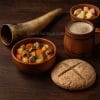
-
Shop by Type
-
Shop by Culture
-
Collections
Home » Blog » Norse & Viking » Viking Symbols and Their Meanings: Discover Powerful Norse Emblems

Viking symbols have fascinated historians, enthusiasts, and modern culture for centuries. These symbols were far more than just visual representations; they embodied the spiritual, cultural, and philosophical values of the Norse people. This post dives into the historical significance of these powerful symbols, their meanings, and their enduring legacy in today’s world.
Viking symbols, also known as Norse symbols, were visual representations used by the Vikings to communicate complex ideas, beliefs, and values. These symbols were often engraved on weapons, jewelry, ships, and stones, and they played a vital role in rituals, religious practices, and warfare. The Vikings believed these symbols carried immense power—protection, guidance, strength, and victory.
Mjölnir, the legendary hammer of Thor, is perhaps the most recognized symbol of Norse mythology. Thor’s hammer was not only a weapon of destruction but also a protective amulet that safeguarded humanity from giants and chaos. Many Vikings wore Mjölnir amulets for protection and blessings.
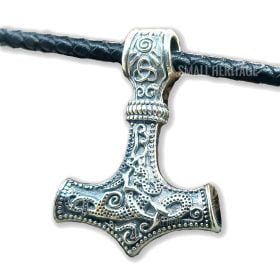
The Valknut, composed of three interlocking triangles, is a symbol associated with warriors who died in battle. Closely tied to Odin, the god of war, death, and wisdom, the Valknut is believed to represent the passage to Valhalla, where warriors are welcomed by Odin after death.
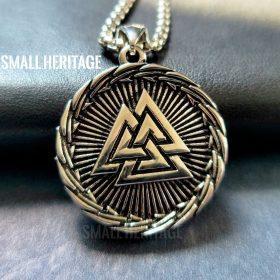
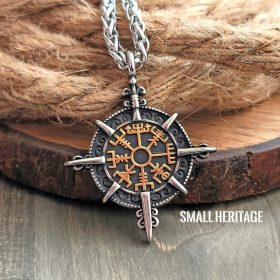
The Vegvisir, often referred to as the “Viking compass,” is a symbol linked with guidance and protection. Although its origins are found in later Icelandic folklore, it is often associated with Viking seafaring culture for its navigational purpose. It is believed to help travelers find their way through rough seas and bad weather.
Yggdrasil, the cosmic ash tree, is central to Norse cosmology, connecting the nine worlds. It represents the cycle of life, death, and rebirth. Its roots reach deep into the underworld, while its branches stretch into the heavens, symbolizing the interconnectedness of all things.

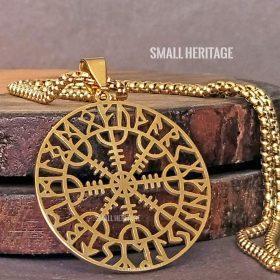
The Helm of Awe is a magical symbol believed to offer protection and power to those who bear it. Viking warriors used this symbol, painting it on their shields and helmets to invoke fear and ensure victory in battle.
Odin’s two ravens, Huginn (thought) and Muninn (memory), represent his all-seeing eyes. These ravens would fly across the world each day to gather information and report back to Odin. Huginn and Muninn are symbols of thought, knowledge, and reflection.
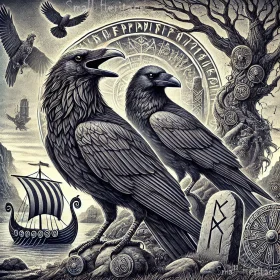
The Troll Cross is a protective symbol that was often worn as an amulet to protect against evil spirits, trolls, and dark forces. It is shaped like a twisted loop of iron, and its curved form is believed to ward off negativity.
Fenrir, the monstrous wolf in Norse mythology, is a symbol of destruction and chaos. Bound by the gods due to his immense strength and predicted role in Ragnarok, Fenrir symbolizes uncontrollable forces and the inevitable destruction that comes with fate.
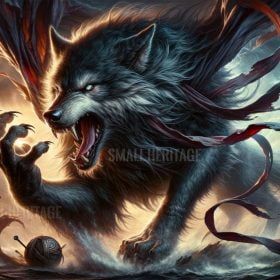
Jörmungandr, also known as the Midgard Serpent, encircles the world and is a key figure in Norse mythology. His immense size and power represent the cyclical nature of life and death, and his release during Ragnarok signifies the end of the world.
Sleipnir is Odin’s eight-legged horse, known for its speed and strength. It is said to carry Odin between the worlds, making it a symbol of travel, strength, and the ability to bridge realms.
Historical Reference: Sleipnir is mentioned in the Poetic Edda, where it carries Odin to the realm of the dead.
Meaning: Strength, swiftness, and travel between worlds.
The Wolf Cross is a symbol that blends the shape of a wolf’s head and a Christian cross, representing a bridge between pagan Norse beliefs and Christianity. It is believed to provide protection and embody the ferocity of the wolf spirit.
Valkyries are female figures in Norse mythology who choose which warriors live and die on the battlefield. They are often associated with fate and destiny, as well as the afterlife. These figures are symbols of death, honor, and battle.
The Raven Banner is a symbol of power, victory, and the connection between Vikings and ravens. It was flown during battles to invoke Odin’s favor, as ravens were sacred to the god. The presence of the banner was believed to ensure victory.
Thor’s goats, Tanngrisnir and Tanngnjóstr, are symbols of strength, endurance, and the cyclical nature of life and death. Thor used these goats to pull his chariot, and after each journey, he would consume their meat, only for them to be resurrected the next day.
The Seer’s Staff, often carried by female seers known as Völvas, is a symbol of prophecy, wisdom, and connection to the spiritual world. The Völvas were respected figures who communicated with the gods and predicted the future.
The Horn Triskelion is a symbol of three interlocking drinking horns, associated with Odin and rituals of mead-drinking. It represents wisdom, poetic inspiration, and the pursuit of knowledge. The symbol is often linked to ancient toasting rituals in Viking culture.
Gungnir is the magical spear of Odin, known for its perfect aim and unbreakable nature. It is a symbol of authority, warfare, and leadership. Odin used Gungnir in many battles, and it is said that the spear never missed its mark.
Skoll and Hati are two wolves in Norse mythology that chase the sun and moon across the sky, representing the cosmic forces of time and change. They are symbols of pursuit, transformation, and inevitable change.
The Viking Solar Wheel, was a symbol of power, prosperity, and the eternal cycle of life, death, and rebirth. Its rotating design was associated with the sun and its movement across the sky, symbolizing continuity and the passage of time.
Nidhogg, the great dragon that gnaws at the roots of Yggdrasil, represents destruction, chaos, and the darker side of the cycle of life. It embodies the forces that seek to undermine the balance of the cosmos and bring about destruction.
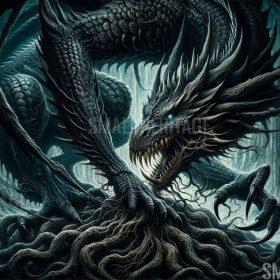
Geri and Freki, Odin’s loyal wolves, symbolize loyalty, ferocity, and the bond between the gods and their animal companions. They represent Odin’s connection to the natural world and his role as a protector of warriors.
Jötnar (or Jötunn) represent the primal forces of chaos and nature. Often depicted as enemies of the gods, they symbolize the struggle between order and chaos, which is central to Norse mythology.
For the Vikings, symbols were not just ornamental designs but sacred emblems that held profound meaning. These symbols were inscribed on weapons, worn as amulets, and even etched into runestones that marked graves and territories.
Symbols like Mjölnir and the Helm of Awe were most frequently used for protection. Viking warriors relied on these symbols to gain divine favor before heading into battle. For seafarers, symbols like Vegvisir were essential for ensuring safe journeys and navigating treacherous waters.
The Yggdrasil and the Valknut were crucial in Viking spirituality. They represented the connection between the mortal and divine realms and were believed to provide spiritual guidance in life and after death. The Valknut symbolized a warrior’s journey to Valhalla, while Yggdrasil stood as a reminder of the cyclical nature of existence.
Viking symbols have transcended time, continuing to hold significant appeal in modern jewelry, tattoos, and art. People today are drawn to the values of strength, wisdom, and protection that these ancient symbols represent. For those fascinated by Viking culture and history, wearing these symbols serves as a meaningful connection to the enduring legacy of the Norse way of life.
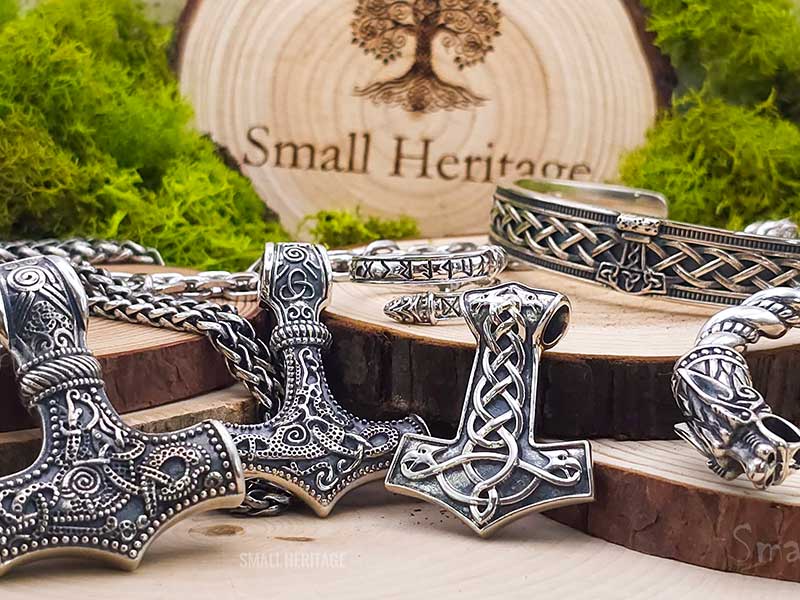
At Small Heritage, we proudly offer a curated collection of Viking-inspired jewelry that honors these timeless symbols. Each piece is crafted with meticulous attention to detail, reflecting the authenticity and reverence for Norse traditions, ensuring that every item embodies the rich history and significance behind these symbols.
Viking symbols are far more than relics of the past—they continue to captivate and inspire across the globe. Whether you are drawn to the protective strength of Mjölnir, the guiding force of Vegvisir, or the wisdom of Odin’s ravens, these powerful emblems carry a timeless legacy that connects us to one of history’s most fascinating cultures.
The enduring presence of Viking symbols is a testament to their profound meanings and deep connection to Norse heritage. Whether you’re a history enthusiast, a modern-day warrior, or simply seeking guidance and protection, these symbols offer more than aesthetic beauty—they embody inspiration, strength, and wisdom.
For a deeper exploration of Norse mythology and Viking symbols, check out our Norse Runes and Their Meanings blog post, where we uncover the mystique behind these ancient emblems.
At Small Heritage, our thoughtfully curated Viking jewelry collection helps you connect with the ancient wisdom and artistry of Norse culture. Each piece represents a unique aspect of Viking symbolism, combining beauty with profound meaning. Explore our Viking jewelry collection today and carry a piece of history with you into the modern world.